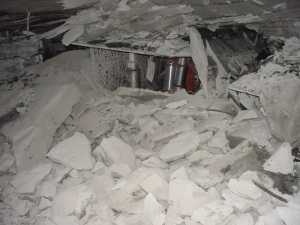Mining Topic: Rock Falls
What is the health and safety problem?
Falls of rock from the roof are one of the leading causes of injuries and fatalities for mine workers.
What is the extent of the problem?
Underground mining still has one of the highest fatal injury rates of any U.S. industry—more than five times the national average compared to other industries. Between 1999 and 2008, nearly 40% of all underground fatalities were attributed to roof, rib, and face falls. Small pieces of rock falling between bolts injure 400–500 coal mine workers each year.
How is the NIOSH Mining Program addressing this problem?

Rock fall.
The NIOSH Mining Program is working to combine empirical, laboratory, and numerical studies to advance the state-of-the-art methods for protecting mine workers from all forms of rock fall. Major roof falls and rib falls are the focus of our current work, including studies to improve the support design methodologies and to provide "best practices" through training and health communications. NIOSH is also funding and collaborating on external research projects. This work focuses on early fall warning devices and improved bolting equipment, which primarily involves smart bolters that evaluate the roof composition and conditions in real time while bolting.
What are the significant findings?
NIOSH has made significant findings in the areas of "best practices" related training and improved fall warning devices. Improvements in technology, such as the use of personal bolter screens to prevent small falls and reduce injuries, have been found to provide significant protection to mine workers in many instances.
What are the next steps?
NIOSH is actively investigating how to protect mine workers from rock falls in ribs of coal mines and apply numerical modeling tools to design support that will reduce large falls of roof. NIOSH Mining’s comprehensive approach to ground control looks at global stability which can be maintained with good pillar design, local stability which can be maintained with good roof controls, and surface or skin control with screening.
See Also
- Comparative Analysis of Moisture Sensitivity Index Tests for Coal Mine Roof
- Diagnosing and Controlling Moisture-Sensitive Roof in Coal Mines
- Dynamic Failure in Deep Coal: Recent Trends and a Path Forward
- Early Strength Performance of Modern Weak Rock Mass Shotcrete Mixes
- Horizontal Stress
- The Introduction of Roof Bolting to U.S. Underground Coal Mines (1948-1960): A Cautionary Tale
- Mistakes, Misconceptions, and Key Points Regarding Secondary Roof Support Systems
- Numerical Model Calibration for Simulating Coal Pillars, Gob and Overburden Response
- Optimizing Secondary Roof Support with the NIOSH Support Technology Optimization Program (STOP)
- Overview of Coal Mine Ground Control Issues in the Illinois Basin
- Performance Characteristics for Welded Wire Screen Used for Surface Control in Underground Coal Mines
- Pillar Strength in Underground Stone Mines in the United States
- Potential of Roof Screening to Reduce Workers’ Compensation Cost
- Preventing Falls of Ground in Coal Mines With Exceptionally Low-Strength Roof: Two Case Studies
- Preventing Injuries Caused by Unrecognized Stone Mine Roof Beam Failures With a Pro-Active Roof Control Plan
- Reduced Workers’ Compensation Costs With Roof Screening
- Stability Mapping to Examine Ground Failure Risk: A Field Study at a Limestone Mine
- Technology News 455 - Roof Hazard Alert Modules
- Time Dependent Roof Deterioration at a Central Ohio Coal Mine
- Page last reviewed: 5/6/2014
- Page last updated: 9/22/2015
- Content source: National Institute for Occupational Safety and Health, Mining Program


 ShareCompartir
ShareCompartir